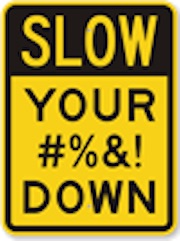We live in an area with a lot of mountains and the roads are mostly two-lanes and have a lot of curves. As you might expect, a lot of the speed limits in our area are less than 55 mph. I’ve noticed lately, that a lot of people are driving quite a bit faster than the posted limits. Also a lot of people don’t seem to know that the yellow line down the middle of the road is not meant to be driven on, but to help you stay on your side of the road… but don’t get me started on that irritation.
Anyhow, whether you appreciate them or hate them, speed limits are important and their intent is to make the roads safer for everyone.
I grew up in Oklahoma and (at the time) it was mostly “open spaces” and the roads were straight and people drove fast. Also, there weren’t that many cars on the road in those days. But since the early days of cars, there has been a debate about freedom versus regulation in regards to speed limits. Some states, like Montana and Nevada, have historically opposed restrictive speed limit laws and imposed minimal fines for noncompliance.
Connecticut was the first state to pass a speed limit law — in 1901. That law limited the legal speed of motor vehicles to 12 mph in cities and 15 mph on country roads. But speed was a concern even before the invention of motorized vehicles. The colony of New Amsterdam (now New York) issued a law in 1652 stating that wagons, carts and sleighs cannot be run, rode or driven at a gallop. Violators of that law faced a penalty that started at two pounds Flemish — about $150 by today’s standards.
New York City introduced the world’s first comprehensive traffic code in 1903. But the adoption of speed regulations, and other traffic codes, was a slow and uneven process across the nation. As late as 1930, a dozen states had no speed limit and 28 states didn’t even require a driver’s license to operate a motor vehicle.

Rising fuel prices contributed to the lowering of speed limits in some states in the early 1970s and in 1974, President Richard Nixon signed a national speed limit of 55 mph into law. These reduced speed limits led to a reduction in the nation’s traffic fatality rate.
Concerns about fuel availability and cost subsided after a while and in 1987 Congress allowed states to increase speed limits on rural Interstates to 65 mph. The National Highway System Designation Act of 1995 repealed the maximum speed limit. That returned control of setting speed limits to the states. Since then, 35 states have increased their limits to 70 mph or higher. Today there is only one country in the world which has no speed limits at all — the Isle of Man. Between 1995 and 1999 Montana had a “reasonable and prudent” speed limit which was non-numerical.
So like it or not, speed limits are here to stay, and none of them are going to please everyone. Some are advocates of the “speed has never killed anyone. Suddenly becoming stationary, that’s what gets you” school of thought….
— 30 —
